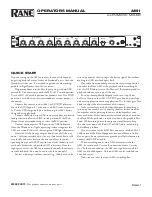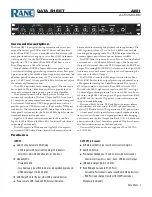
Revision C • 10/07
H
A
R
R
I
S
C
O
R
P
O
R
A T
I
O
N
2-4
2 Installation
Remove the Dual Fader panels that need to have
their rotary switches changed (from the default 0
settings) from the mainframe (see page 5-3 for
panel removal instructions). The console power can
be left on while unplugging and reconnecting the
Dual Fader panels.
Unplug the red CAT-5 cable from the panel and
turn the panel over. Several openings—for the RJ-
45 jack, two rotary switches and the PROM, are
on the back cover (shown on the previous page).
The two rotary switches are labeled 0 - 7 with
an arrow indicating the currently selected num-
ber. The upper switch sets the Telco number or
CR mic setting for the left channel strip. The lower
switch sets the Telco number or CR mic setting for
the right channel strip. If a channel strip is not a
Telco channel or a possible CR talk source, set the
switch to 0.
Change the rotary switch to position 1 to set
that channel strip as Telco 1; to position 2 to set
that channel strip as Telco 2; and so on up to po-
sition 6 which sets that channel strip as Telco 6.
Change the rotary switch to position 7 for those
channels that will have the control room talkback
mic as a source.
Once the Dual Fader panel’s rotary switches are
set, plug the red CAT-5 cable back into the RJ-45
connector and refasten each panel to the main-
frame. Verify that all channels set as Telco chan-
nels have lighted Talkback buttons. If desired, the
Talkback button cover can be replaced by a clear
cover and a label to identify each Telco channel.
There are no other adjustments or settings re-
quired on the Dual Fader panels.
CONSOLE DISPLAY
Two console displays are available: the original
tall direct-view display (90-1950) and the low-
profile reflective display (99-1975-1). Each is po-
sitioned on the countertop behind the back of the
mainframe. The 99-1975-1 is supplied standard
and the original display (90-1950) is available as
a special order. The 90-1950 is powered by a sepa-
rate 5-volt wall-wart supply (included) that plugs
into the back of the display. The low-profile dis-
play uses 48 VDC from the console. Each display
has a captive six-foot umbilical cable to carry the
meter signals, meter name display data and timer
control wires. These cables plug into keyed con-
nectors on the back of the mainframe.
Two horizontal stereo bargraph meters, with al-
phanumeric displays (PROGRAM 1, CUE, etc.)
to identify the signals, a slaveable clock, and an
event timer, are provided on each display.
The meters provide simultaneous level moni-
toring of the Program 1 bus on the left-hand meter
and another bus or system signal on the right-
hand Auxiliary Meter. The Aux Meter buttons on
the Monitor Control panel select the source for
Program 1 Meter Auxiliary Meter
Clock
Event
Timer
Original RMXd
Console Display
Clock set
switches
(on bottom)
Program 1 Meter Auxiliary Meter
Clock
Event
Timer
Low-Profile Reflective Display
Clock set
switches
(recessed)
Содержание RMXDIGITAL
Страница 2: ...Revision C 10 07 H A R R I S C O R P O R A T I O N ii...
Страница 90: ......
















































